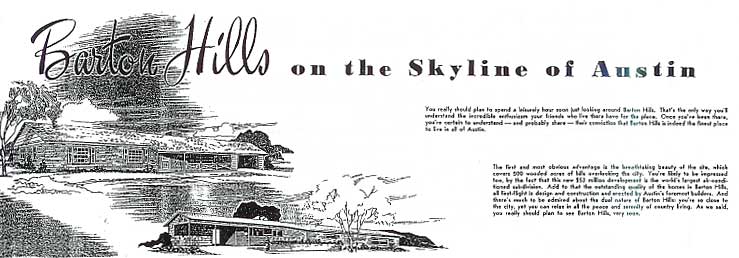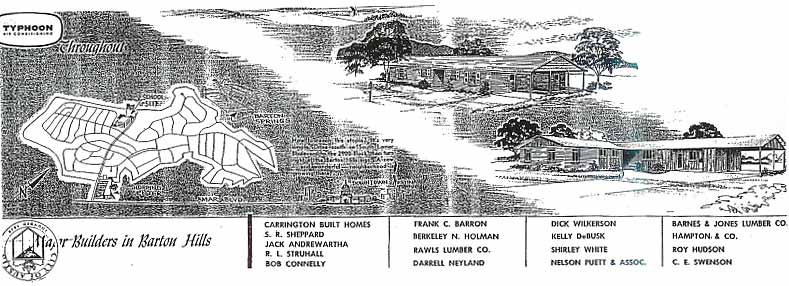|
HISTORY OF BARTON HILLS
By Dick Kallerman
The U.S.G.S. topographic map was dated 1955. I pored over it, looking for signs of habitation east of Barton Creek, where Barton Hills is now. I was surprised to find that there was nary a house between Rabb Road and the Creek, except for an enclave of a dozen or so very special houses built by A.D. Stenger in the “Contemporary” style. This style, popular for a while after the war and owing a lot to Frank Lloyd Wright’s “Prairie style,” is characterized by gently sloping, sheltering roofs, clerestory windows, and a merging of indoors and out with decks that extend into the treetops. Strolling today along Rundell and Airole Way, you realize that homes here in Barton Hills are some of Austin’s architectural wonders.
Barton Hills was featured in Austin’s 1956 Parade of Homes as “the world’s largest air conditioned subdivision.” Beginning in that year, it was platted as subdivision in six sections by S.R. Sheppard, Builders Development Corporation and others. Barton Hills eventually had 1,585 lots planned on its 535 acres (0.84 square mile). In 1990, the population was 6,796. Still growing, we now have 8,036 Barton Hills neighbors, according to the 2000 census.
The banks of the Colorado River have long been a lively place. Dinosaur footprints 99 million years old can be found in Zilker Park, and artifacts indicate the presence of Native American camps near Barton Springs some 11,000 years ago. So you might say that ours is one of the oldest neighborhoods in Central Texas.
The Spanish established three missions near Barton Springs in 1730-31, but soon abandoned them. In 1826 what is now Barton Hills was part of a large tract of land on “Spring Creek” in the Mexican State of Coahuila y Tejas. It was granted to Empresario Benjamin R. Milam and known as Milam’s Colony. This is the same “Old Ben” Milam who led the Texan assault on San Antonio against Mexican regulars in December of 1835 and who died in that bloody house-to-house fighting.
The year after the 1836 Texas Revolution, William “Uncle Billy” Barton patented the land near the springs. A colorful character, he named the main springs after his daughters, Parthenia, Eliza, and Zenobia. He ran a gristmill and kept two baby bison to amuse visitors.
Barton Springs have been an attraction from the earliest days. One who came to visit, the story goes, was Lt. Col. Robert E. Lee. The road named after him, skirting the Springs, was a common path for soldiers on their way to the western forts after Texas was annexed. A merry-go-round was built at the Springs, and later an ice-making plant.
In 1875 you could take the steamboat Sunbeam for an excursion from Austin, then a nearby city, to Barton Springs for a round-trip ticket price of 50 cents. Early in the twentieth century, the land around the Springs was acquired by Andrew J. Zilker, who deeded it to the City of Austin as a park in 1918 and 1931, on the condition that the City support vocational education in Austin schools.
Some of our neighborhood’s defining natural features were swept away on the development drawing board: a water fall and natural pool lie buried in the shadows of the bridge on Barton Hills Drive, and our highest hill (Sugarloaf?) with its commanding views should have been a park.
In the 1972 presidential election, Barton Hills was described as a political bellwether–a statistical microcosm of the national population–and was briefly famous as such. As one neighbor said, “We’re so average, we’re unaverage.”
Today, what was once a developer’s dream on the outskirts of Austin is now a centrally located, mature, and cohesive neighborhood–a good place to live and raise a family.
|
|

